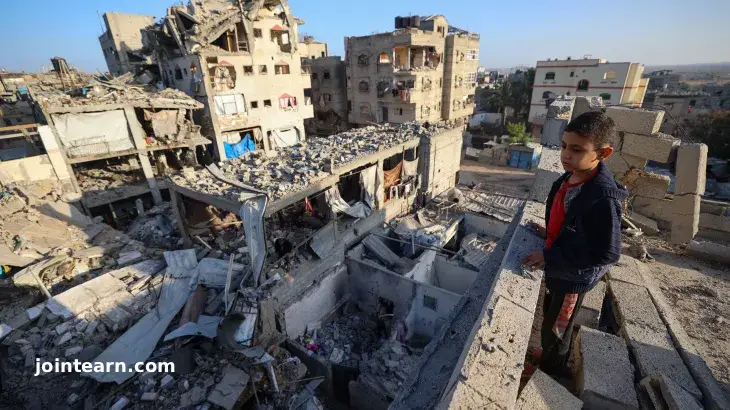
Gaza City — October 20, 2025 — Israel has continued launching air strikes and ground assaults across the Gaza Strip despite a US-brokered ceasefire with Hamas, sparking fears that the fragile truce could collapse just ten days after it took effect. According to Gaza health authorities, at least 100 Palestinians have been killed since the ceasefire began on October 10, in what United Nations officials have called “blatant breaches” of international humanitarian law.
The Palestinian Civil Defence reported that four civilians were killed on Sunday in the al-Shaaf area, east of Tuffah in Gaza City, when Israeli forces opened fire on residents attempting to return to their destroyed homes. Witnesses described scenes of panic as survivors tried to retrieve belongings from the rubble.
“We saw the maps, but we can’t tell where those lines are,” said Samir, a 50-year-old resident of Tuffah. “The whole area is in ruins. No one knows what counts as a safe zone anymore.”
Confusion Over Ceasefire Boundaries
The “yellow line”, a demarcation zone established under the ceasefire deal brokered by US President Donald Trump, has become a major flashpoint. Israel’s military claims it fired on militants who crossed the line in the Shujayea neighborhood, while Palestinians say civilians were targeted without warning. The zone lacks clear physical markings, adding to the chaos on the ground.
Since the truce began, multiple skirmishes and retaliatory strikes have erupted, with both Israel and Hamas accusing each other of violating the terms of the agreement.
On Sunday, Israeli warplanes bombed several sites, killing 42 Palestinians, including women and children. Israel claimed the strikes were in response to a Hamas attack that allegedly killed two Israeli soldiers in Rafah, in southern Gaza. Hamas denied any involvement, calling the accusation a “fabricated pretext to resume aggression.”
Humanitarian Crisis Deepens
The Israeli government briefly halted humanitarian aid deliveries into Gaza on Sunday, worsening conditions for the enclave’s two million residents. Although the United Nations later confirmed that aid shipments had resumed, Al Jazeera’s correspondent Tareq Abu Azzoum reported that several checkpoints continued to block supply convoys.
“Dozens of aid trucks filled with food, water, and medicine are stuck at military crossings,” Abu Azzoum said. “The people of Gaza remain trapped between starvation and bombardment.”
Philippe Lazzarini, head of the UN Relief and Works Agency (UNRWA), urged both sides to maintain the ceasefire and investigate all violations.
“The fragile ceasefire in Gaza must be upheld,” Lazzarini wrote on X. “Civilians have already suffered enough.”
Rising Tensions and Diplomatic Push
Amid the escalating violence, US envoys Steve Witkoff and Jared Kushner arrived in Israel on Monday to meet Prime Minister Benjamin Netanyahu and push for renewed compliance with the truce. US Vice President JD Vance and Second Lady Usha Vance are expected to visit Israel on Tuesday to reinforce American mediation efforts.
The next phase of the ceasefire agreement includes Israel’s gradual withdrawal from remaining occupied zones in Gaza, disarmament of Hamas, and the creation of an internationally backed “Board of Peace” to govern the territory’s reconstruction.
In Cairo, Egyptian mediators hosted talks with senior Hamas official Khalil al-Hayya to discuss implementation challenges. Hamas, however, has rejected the idea of a foreign-led administration in Gaza, calling it a violation of Palestinian sovereignty.
“We will not accept any foreign body ruling Gaza,” a Hamas spokesperson stated. “Our resistance is legitimate until all occupation forces withdraw.”
Trump’s Remarks and Internal Hamas Struggles
Commenting on the fragile ceasefire, President Trump blamed Hamas for internal “rebellions” within its ranks, implying that rogue units might be responsible for some truce breaches.
“They have to be good, and if they’re not good, they’ll be eradicated,” Trump said, while insisting that US troops will not deploy on the ground.
Hamas security forces, meanwhile, have resumed patrols across Gaza, reportedly clashing with rival factions and executing suspected criminal gang members. Trump last week downplayed those incidents, saying, “They took out a couple of very bad gangs — and that’s okay.”
Outlook: A Fragile Peace on the Brink
As Gaza reels from continued violence, international observers warn that the ceasefire could collapse entirely unless both parties re-commit to restraint. The situation has left ordinary Palestinians struggling to rebuild amid widespread destruction, food shortages, and fear of renewed bombing.
“Every time there’s a truce, we start to hope,” said Amina al-Haddad, a mother of three in Khan Younis. “Then the bombs return, and hope disappears again.”
With diplomatic efforts intensifying but distrust deepening, the fate of Gaza’s fragile peace — and the lives of millions — hangs in the balance.
Leave a Reply